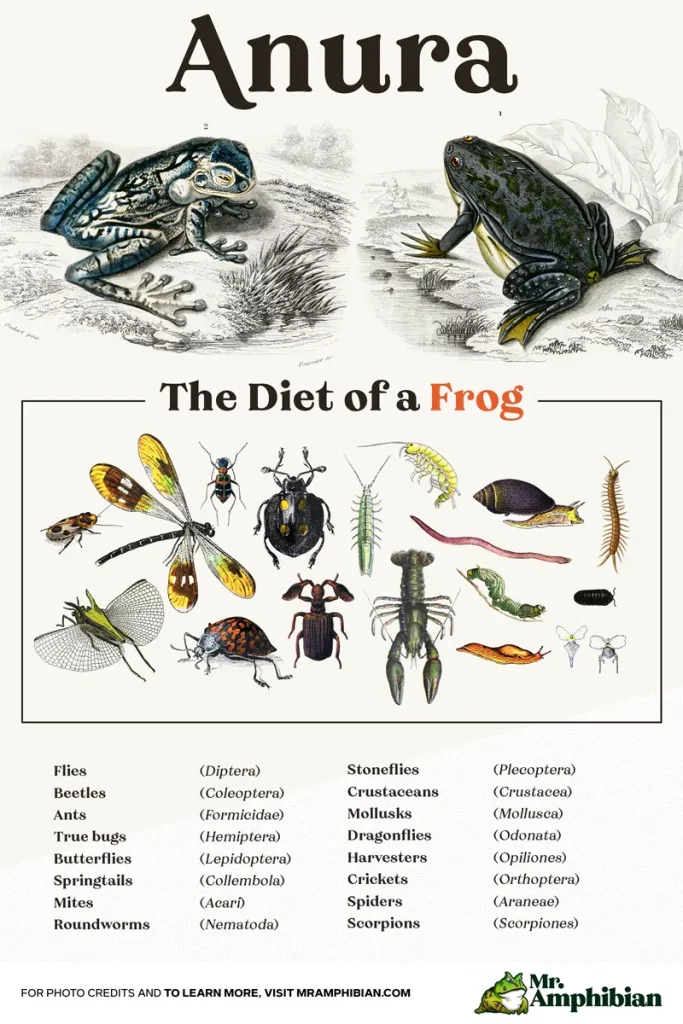Frog & Toad Diet: Pet Feeding Guide
Amphibians are opportunistic feeders, eating bugs small enough to fit in their mouths. Frogs, of course, belong to class Amphibia. Frogs thrive on a variety of insects and small invertebrates.
Also, let me clear any confusion: toads are a type of frog. There is little difference from a taxonomic standpoint. So, this feeding guide works for both frogs and toads because they share the same diet.
Tadpoles eat differently than mature frogs. Because of this, I created a separate feeding guide for tadpoles. Now that you know what to expect – let’s get started!
Table of Contents
So, What Do Frogs Eat?
Frogs eat bugs and creepy crawlies: flies, ants, true bugs, bees, worms, beetles, isopods, wasps, bees, spiders, crickets, and more. Their well-being depends on diversity.
Large frogs and toads (Anurans) can eat small fish, lizards, snakes, mice, crayfish, and other amphibians.
In captivity, frogs and toads do not have access to a large array of bugs. They’re limited to what their keeper acquires at the local pet store or cultivates independently.
Because of this, amphibians in captivity are less healthy than their wild counterparts. Measures should be taken to keep a pet frog healthy.
Before we get into that, let’s see what frogs eat in the wild.
Frogs eat the following:
- Butterflies, Moths, Flies (Lepidoptera and Diptera) – Winged insects make up a large portion of a frog’s diet. Fly larva is a popular food source for tadpoles, too.
- Wasps, Bees, Ants (Hymenoptera)- Another group of winged insects belonging to a different order.
- True Bugs, Cockroaches, Grasshoppers, Locusts, Crickets – True bugs account for a large portion of a wild frog’s diet. Crickets comprise a small percentage of a wild frog’s diet. In captivity, they’re the most common food source.
- Beetles (Coleoptera) are among the largest order of bugs in the world and a great food source for frogs.
- Worms, Millipede, Centipedes, Slugs, Snails – Small invertebrates are readily consumed by frogs. In captivity, mealworms, superworms, waxworms, and horned worms are popular.
- Springtails, Termites, Isopods – Microfauna like isopods, termites, and springtails make a quick snack for frogs and toads.
- Spiders, Scorpions – Arachnids and small scorpions are popular, easy targets.
Large frogs can eat:
- Snakes, lizards – Small species or juvenile reptiles are occasional foods.
- Fish, Crayfish, Crustaceans – Small fish and crustaceans are an easy target for large amphibians, especially fully-aquatic species.
- Frogs, Salamanders, Caecilians – Other amphibians, even frogs and tadpoles, are readily consumed by their own kind.
- Mice and other small mammals – Pinkie mice (baby mice) and other small mammals are occasional meals, too.
A study of southern frogs (leptodactylidae) showed a difference in diet depending on whether they lived in a wild or urban environment. Both groups ate a lot of wasps, bees, and ants. The urban frogs consumed more beetles while their wild counterparts ate more butterflies and moths[1].
A different study by the University Malaysia Sarawak examined the gut contents of 83 Asian horned frogs (Megophryidae)[2]. More than half consisted of termites, wasps, bees, and ants. The rest was a combination of grasshoppers, beetles, butterflies, and moths.
Why does this matter? Well, I mentioned these studies to illustrate how a frog’s diet differs depending on its environment. Simply put, frogs eat whatever insects are readily available.
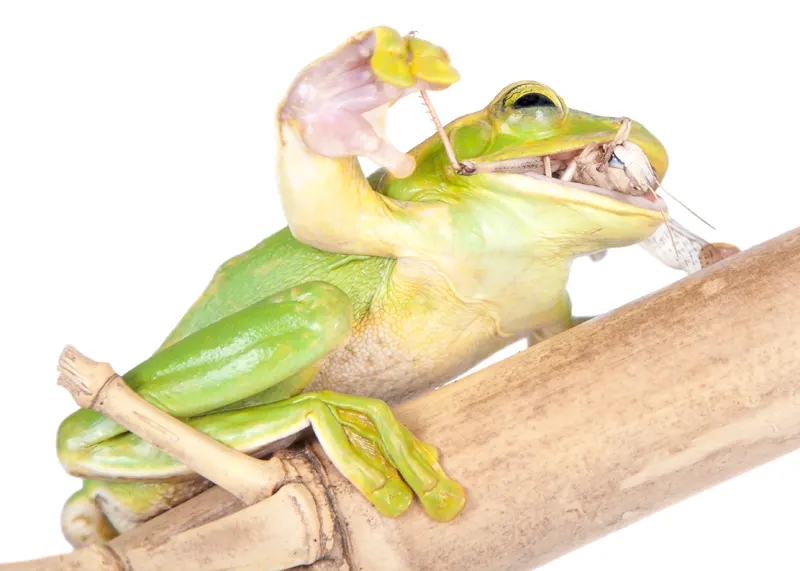
How To Feed Your Pet Frog
Feeding frogs and toads can be tricky. It’s not as simple as filling a bowl with kibble. As we learned in the last section, frogs need live insects.
On top of that, the herptile community doesn’t have definitive guidelines for feeding reptiles or amphibians. We need more information. More research.
Still, zoos, herpetologists, and hobbyists agree on a few basic principles. Keep in mind every species is different, but the list of rules below will guide you in feeding your pet(s).
- Use a variety of insects. The larger the variety, the better. Most pet stores offer crickets, mealworms, dubia roaches, wax worms, wingless fruit flies, and more. When possible, offer different bugs to your frog rather than just crickets, for example.
- Feeders should be appropriately-sized. The insect size should not be so large that your pet chokes or hurts itself while eating. See the illustration below.
- Monitor for overeating and undereating. Some species are prone to overeating, while others need food available 24/7. Research your frog’s requirements, watch their weight, and pay attention to their health so you can adjust their feeding as needed.
- Gut-loading feeder insects. Feeders are low in nutritional value. Due to this, most hobbyists give their feeders a nutrient-rich diet 48 hours before feeding them to their pets. More about this in the section below.
- UVB or supplements. Captive frogs are prone to MBD (Metabolic Bone Disease) due to low calcium. Either a UVB light or supplements are recommended. Most hobbyists opt for dusting their feeder insects with a calcium powder supplement.
- Wild caught insects are frowned upon. If your pet doesn’t come from your part of the world, it might not be adapted to handle little parasites found in the local insect population. For this reason, hobbyists prefer to use feeder insects.
Now that you know the basics, I’ll guide you in finding feeders, gut-loading, supplements, and more.
Feeder Insects & Where To Get Them
Feeder insects (also known as “feeders”) are available in most pet stores. They receive shipments multiple times per week or cultivate their own to keep up with demand. The most common feeders are:
- Crickets
- Mealworms, wax worms, horned worms
- Dubia roaches
- Wingless fruit flies
- Brine shrimp, feeder fish
- Pinkie mice
Among those listed above, crickets are the most popular feeder insect for reptiles and amphibians. They’re easy to cultivate, cheap, and come in different sizes: pinhead (tiny), small, medium, and large.
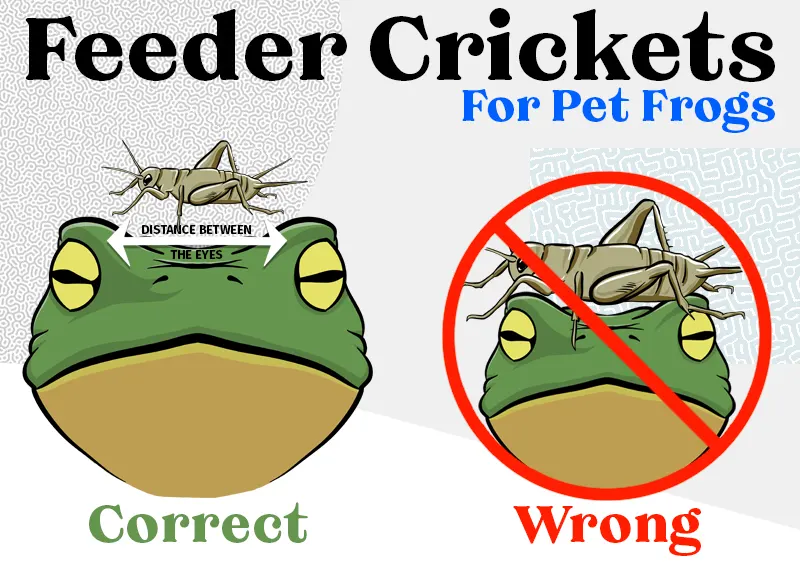
If you do not want to raise feeder insects yourself, here are four places you can buy them:
- Local pet stores
- Online
- Local breeders (check Facebook)
- Reptile conventions
I recommend raising your feeders or buying them from a local breeder or pet store. I ordered crickets online, and most of them were dead on arrival.
Gut-Loading Insects
Gut loading is the process of feeding insects a nutritious diet for 48 hours before feeding them to your animals. This ensures the insect’s gut is loaded with healthy vitamins and minerals, which are passed to your pet frog upon feeding.
To gut load a cricket, for example, you can feed them fruits and vegetables for two days before feeding the crickets to your frog. Some popular methods of gut loading include:
- Sliced fruits & vegetables – Slice an orange or lemon, along with a tomato or sweet potato, and place them in the container with your crickets. Be sure to change them out before they go bad.
- Blend fruits & vegetables – This is great for vegetables that aren’t juicy. Simply blend vegetables and fruits together, adding a small amount of water with it. Put the blended mixture into the cricket’s enclosure.
- Commercial Mix – Some people prefer to use commercial gut-load mixtures. Repashy’s Bug Burger and Bug Grub are two examples (links go to Amazon).
Finally, there are calcium gels. Fluker’s “cricket quencher” is one example, but there are other brands. Don’t use these in addition to dusting crickets with a calcium powder supplement.
“Dusting” with Supplements
Because feeder insects are low in nutritional value, most hobbyists opt for “dusting” them with supplement powders. The most common supplements are vitamins and calcium.
A multivitamin supplement is almost always a good idea. However, you need to be careful with calcium. It’s important for healthy bones, but you don’t want to overdo it.
Avoid using a calcium supplement if you’re gut-loading feeders with calcium or providing the correct level of UVB lighting. Otherwise, use a calcium supplement.
My favorite brand is Rep-Cal. They offer Calcium with D3 and Herptivite (both links go to Amazon).
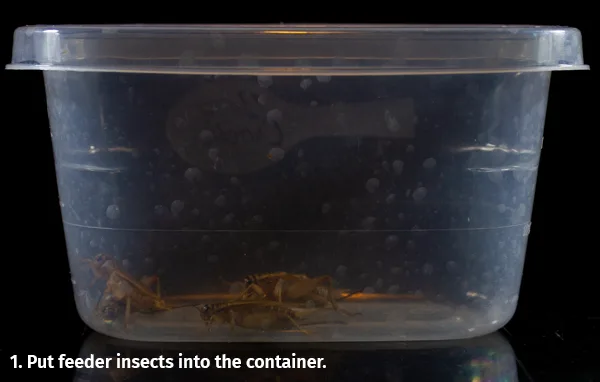
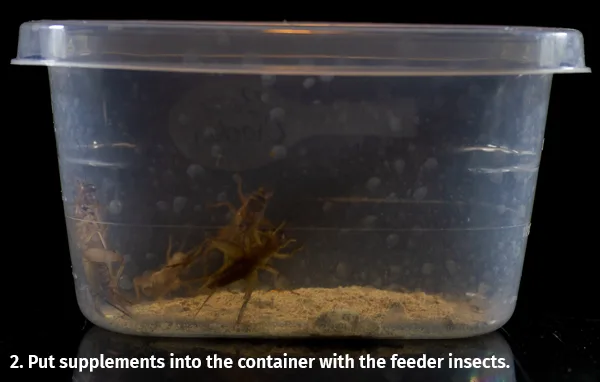

Below are instructions for dusting feeder insects with a supplement powder:
- Put the supplement powder into a bag or small plastic container with a lid.
- Place the feeder insects into the container with the supplement powder.
- Gently shake for several seconds. This will coat or “dust” the insects with the supplement powder.
Now all that’s left is to feed your pets!
Creating A Feeding Schedule
There is no one-size-fits-all schedule for feeding frogs. Each species is different. Below are general guidelines.
- Feed young frogs every 1 to 2 days. Adults should be fed 2 to 3 times per week.
- Over-eating and under-eating is possible. Make adjustments based on the size/health of your pet. An overweight frog should eat less, while an underweight frog should eat more. See the body condition score section below.
- Start with 3 to 4 appropriately-sized crickets per feeding.
- Alternate feeder insects as much as possible.
Here is a basic feeding schedule to help you get started. You may need to make adjustments.
| Juvenile Frog | Adult Frog | |
|---|---|---|
| Monday | 2 – 3 insects | 3 – 4 insects |
| Tuesday | 2 – 3 insects | |
| Wednesday | 3 – 4 insects | |
| Thursday | 2 – 3 insects | |
| Friday | 2 – 3 insects | |
| Saturday | 3 – 4 insects | |
| Sunday | 2 – 3 insects |
You may wonder how to tell if your frog is overweight or underweight. After all, this is how you will know whether or not to adjust your feeding schedule. This can be accomplished by looking at a body condition score (BCS).
Body Condition Score (BCS) for Frogs
At the time of writing this, there is only one research article with a body condition score for single species of frog; the mountain chicken frog[3].
The difficulty of creating a body condition score for frogs is that they’re all very different. A healthy red-eyed tree frog, for example, looks skinny. Meanwhile, a healthy Pacman frog looks overweight.
Regardless, I encourage you to view the BCS created by the Zoological Society of London for reliable information regarding this subject. Meanwhile, I created a frog/toad BCS illustration. You can see it below.
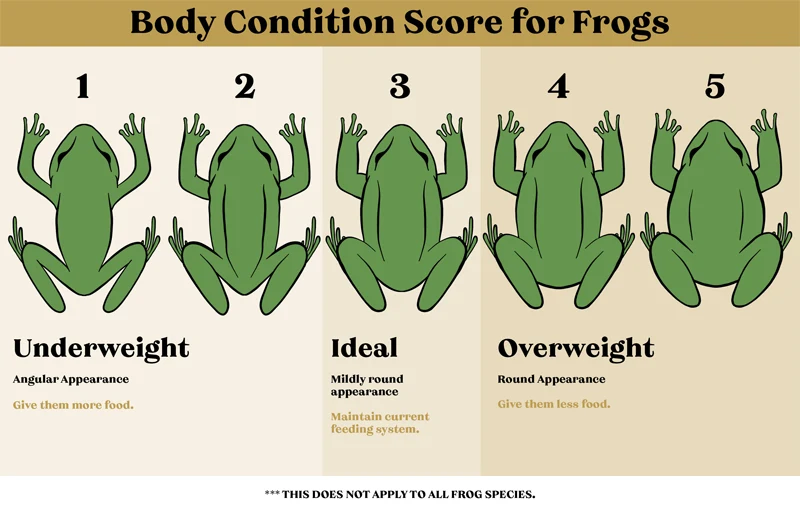
Step-by-step Feeding Instructions
Once you’ve learned what frogs eat and are confident you’re giving them a balanced diet, you can begin feeding. This step-by-step guide will help you going forward.
A step-by-step guide to feeding frogs or toads in captivity.
- Decide on a time
The best time to feed your frog depends on the species. For example, most tree frogs eat in the evening, just as the sun goes down. If you can’t find the best time, any time will work.
- Choose appropriately-sized feeder insects.
Once you’ve decided which type of feeder insect to use, make sure they’re not too big. Frogs can choke or hurt themselves, trying to eat something too big.
- Dust with supplements or gut-load before
Either dust the feeders with a supplement or gut-load the feeders at least 48 hours before feeding them to your frog.
- Place the feeders inside your frog’s enclosure.
Gently place the feeders inside your frog’s enclosure. Some hobbyists prefer to use feeding tongs, especially when feeding species like Pacman Frogs or African Bullfrogs. For enclosures with lots of water, place something in the water to keep crickets from drowning. A small piece of cork bark will float on the surface and provide a way for them to climb out of the water.
- Wait and watch
One of the coolest things about keeping amphibians is watching them eat. So long as your pet is awake, it will likely strike fast. Sit back and observe.
Feeding tongs are a good investment, especially for aggressive species like Pacman frogs. Tongs allow you to hold a cricket directly in front of your pet without fear of getting bit.
Frequently Asked Questions
This section is meant to answer some of the most common questions regarding a frog’s diet and how to feed them.
No, not really. Frogs are primarily carnivores. They eat living insects. Tadpoles and fully-aquatic frogs may occasionally eat pieces of bread but it is not good for them. Do not feed them bread.
Some frogs bite, but most do not. Frogs would rather flee than fight. When a frog bites, they have likely mistaken your finger for an insect, or it’s an aggressive species and feels threatened.
Most frogs do not eat plant matter as adults. In rare cases, some occasionally eat plant matter for various reasons, but it’s rare. Again, frogs eat live insects and will not survive on lettuce, grass, or plant matter.
Frogs absorb water through their skin. They do not drink water as we do. Water is very important for frogs and other amphibians.
Small/juvenile frogs eat smaller versions of what they eat as adults. Feed them “pinhead” crickets or wingless fruit flies in captivity.
It’s likely that wild frogs will find plenty of insects in your garden naturally, without your help. Consider placing a solar-powered light along a pathway. The small light will attract bugs at night, attracting frogs and toads.
No, not really. Frogs eat live insects. Tadpoles and fully-aquatic frogs may nibble on pieces of chicken but it’s not good for them. Do not feed them chicken.
According to the National Research Council, subcommittee on Amphibian Standards, adult frogs can survive for 3 to 4 weeks without feeding. However, long-term survival requires weekly feeding [4].
Frogs almost never eat dead insects. They don’t recognize it as food. Frogs are ambush predators, waiting for living insects to walk by. Do not feed them dead crickets.
No, they do not. It may surprise you to learn that some frogs have teeth but they don’t use their teeth for chewing. They’re used for holding on to the prey before swallowing it whole.
Infographic credits: Salamander [5], Salamander and Caterpillar [6], Insects, Crustaceans, and Mollusks [7], Millipede, Worm, and Isopod [8]
References
- Santana, Diego José, et al. “Diet of the Rufous Frog Leptodactylus Fuscus (Anura, Leptodactylidae) from Two Contrasting Environments.” Herpetozoa, vol. 32, 2019, pp. 1–6. Crossref, https://doi.org/10.3897/herpetozoa.32.e35623.[↩]
- University Malaysia Sarawak. “Diet Habits of Frogs (Family: Megophryidae) in Kubah National Park.” Research Gate, 2018. ResearchGate, dx.doi.org/10.13140/RG.2.2.28317.61927.[↩]
- Jayson, Stephanie, et al. “Development of a Body Condition Score for the Mountain Chicken Frog (Leptodactylus Fallax).” Zoo Biology, vol. 37, no. 3, 2018, pp. 196–205. Crossref, https://doi.org/10.1002/zoo.21409.[↩]
- National Research Council (US) Subcommittee on Amphibian Standards. “Amphibian Management and Laboratory Care.” National Research Council (US) Subcommittee on Amphibian Standards, 1974. NCBI, www.ncbi.nlm.nih.gov/books/NBK217594.[↩]
- Photo credit: Charles Dessalines D’ Orbigny, Dictionnaire Universel D’histoire Naturelle – CC0 Public Domain[↩]
- Photo credit: George Shaw, The Naturalist’s Miscellany – CC0 Public Domain[↩]
- Photo credit: Basicmoments / adobe stock[↩]
- Photo credit: Joris Hoefnagel, The National Gallery of Art – CC0 Public Domain[↩]

